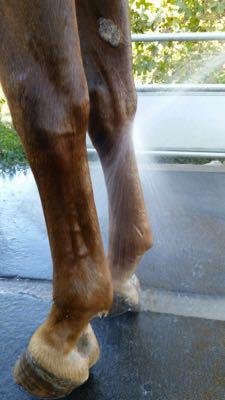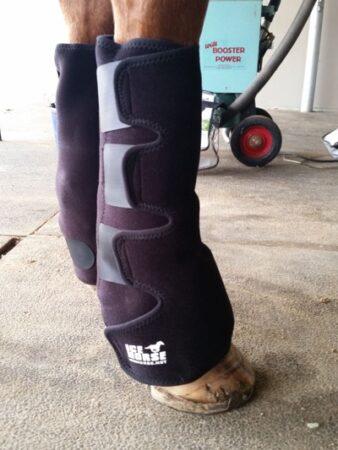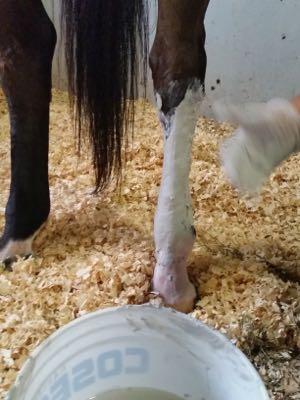Post-Exercise Leg Care for Horses – Ice, Poultice, Sweats, and Liniments
The legs of your horse are critical – and it’s up to us as riders and horse owners to monitor them daily and notice any subtle (or not so subtle) changes. After a ride, you have a minimum of three things to do to your horse’s legs! You may also need to do a little more post exercise leg care, depending on many factors.
Jump to shopping for leg care products
Things to think about when deciding on a leg care plan
- Does your horse have previous injuries?
- How hot are the legs? Boots on a horse in the heat of summer create excessively hot tendons! Even without boots, there is significant heat in the soft tissues. And don’t believe for a second that winter weather prevents heat from forming in the tissues.
- What was the footing like?
- How strenuous was the exercise for your horse? Keep in mind that a casual trail ride can be strenuous – uneven footing and rocks challenge your horse’s legs!
- Did your horse knock himself?
- Did your horse zig and zag during a spook or shenanigans?
- Does your horse receive joint supplements as part of his daily meals?
The bare minimum of post-exercise leg care:
- Pick your horse’s hooves.
- Check legs for swelling, abnormal or localized heat, lumps, bumps, scrapes, cuts, anything that is new on the legs.
- Make sure the tendons come back to the pre-workout condition – temperature and cleanliness. Sweat and dirt and icky legs can often lead to skin infections, especially if there is a tiny nick or cut. A good cold hosing helps.
- This bare minimum treatment is essentially the same as the inspection you would do before your horse exercises. This is appropriate after any exercise that is low impact on nice level ground with great footing, drama-free, and shorter in duration.

Ice your horse’s legs:
- Icing your horse’s legs cools the tendons, soft tissues, and hooves.
- Icing reduces inflammation in the tendons, ligaments, and joints. Arthritis in joints is painful and can be helped by ice therapy.
- Helps prevent long-term wear and tear on your horse’s legs.
- Works to prevent soreness after exercise – the same soreness you get after a workout.

Icing is great on so many levels.
- Some horse folks believe that icing a horse’s legs is only needed when there’s an injury, but as my veterinarian reminds me – PREVENTING damage from heat and exercise is much easier, cheaper, and less heartbreaking than TREATING damage from an injury. So ice can be part of your daily routine.
You can also use a poultice.
- A poultice is another way to “cold” treat your horse’s legs. Poultice, typically clay-based, acts by drawing out heat from a leg. Most of us also use a standing bandage around the poultice to prevent a nasty clay-based mess, which increases the warmth of the leg.

Clay! Clay! Clay!
Sweat your horse’s legs.
- There is also an option for a sweat, which is a way of adding heat to a portion of the leg. This is not typically done after exercise, but in some cases (like long-term injuries) your veterinarian may suggest a sweat.
- Sweats are typically a gel concoction, such as furazone, which is applied to the tendons of the lower leg of the horse and then wrapped with plastic wrap and then a standing wrap. They are messy! Generally speaking, heat works well for older injuries or arthritic conditions.
- If you are dealing with an injury, your veterinarian can give you a specific plan for using ice and heat to treat an injury. It’s typical to use cold treatments initially to prevent inflammation from getting out of control and then add heat treatments like a sweat later to promote circulation.
Or you can try a liniment after your horse exercises.
- Your next option is to use a liniment, which is a liquid or gel formula designed to “brace” a horse’s muscles and soft tissues. Liniments can be cooling or warming. Liniments are often also good for antiseptic use, meaning they can help with small cuts or abrasions. Joints may also benefit from the use of a liniment. The application is easy, often with a spray bottle! Some ingredients will test positive at shows, so know you showing rules and the ingredients of your liniment!
- Whatever your post-exercise routine is for your horse’s legs, it’s important to involve your veterinarian and your trainer when designing a care plan. Most of this care is preventative in nature, your horse will thank you for it! To learn more about cooling and heating options for horses you can read this article here.

Stock up here for your horse supplies! As an Amazon Associate, I earn from qualifying purchases, but it’s ZERO extra cents to you. You can also visit my Amazon storefront here: PEG storefront.
If hooves are your jam, this book is for you.
and adds a nice sheen!
A simple and trusted hoof supplement.
For added squish during laminitis or other painful hoof trauma.
The gold standard for stinging hooves and anytime you need to pack the hooves.
Hi-quality no-bows with Back On Track reputation (that's good!)
These boots are the gold standard for jumpers and horses that like to interfere.
Support and softness for laminitis and other painful hoof conditions.
Buy bulk and save! This is great for stubborn hoof infections like seedy toe and thrush.
These squishy quilts are the perfect mix of no-bows and thicker quilts.
Feed your horse's hoof health from the inside out.
This supplement helps high-laminitis risk horses and has calming ingredients like magnesium.
The gold standard for bell boots in a rainbow of colors.
Classic, clean, stylish boots for your horse. Great for jumping.
Be practical when wrapping your horse's legs with a traditional color, but toss in some spice with the understated pattern!
Protect your horse's legs and let them shine bright.
These boots are my favorite for wrapping hooves with poultice or clay and a diaper. No more duct tape boots! You can also use inserts with these for more squish.
This style is great to protect the hoof, but is not soft and squishy for laminitis cases.
Show off your horse's legs with these safe, reflective, and fashionable boots.
These boots are great for protecting barefoot horses.
These SilverSox are great for protecting the legs from rubs, help with scratches and mud fever, and provide some compression, too.
Simple! Easy!
Take the heat out, reduce inflammation, help prevent long-term damage, and dress your horse in cute colors after a ride.
These are amazing for riding. They take some wrestling to get on, but they will stay on.
Thank you!















































































































